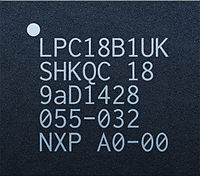Apple M8
| Apple M8 | |
|---|---|
 Representation of the Apple M8 |
|
| Production: | since September 2014 |
| Producer: | NXP Semiconductors |
| Processor clock: | 150 MHz |
| Instruction set : | ARM Thumb |
| Microarchitecture : | Cortex-M3 |
| Name of the processor core: | ARM Cortex-M3 |
The Apple M8 is a coprocessor for sensor data acquisition from the US company Apple Inc. It can acquire and process data from various motion sensors of a mobile device in a power-saving manner and independently of a main CPU .
function
The M8 can record, process and temporarily store the data from the motion sensors, even when the entire device is in a power-saving idle state. User programs can then query this data at a later point in time. This reduces the average power consumption and extends the battery life. The data preparation also provides information about the type of movement, such as walking, running or driving.
technology
The chip with the code name works with an ARM Cortex-M3 CPU and has the designation LPC18B1UK .
Use in Apple devices
The processor is used in the iPhone 6 and the iPad Air 2 , where it takes care of a large part of the sensor data acquisition and processing. Applications communicate with the chip via the so-called Core Motion API of the iOS operating system . This allows, for example Fitness - Apps to track the user's movements and prepare.
relevance
With the introduction of the A7 SoC , Apple specifically advertised another chip on the logic board of an iOS device for the first time . Even before the introduction of the Apple M7 , iOS devices had already installed motion coprocessors, for example since the first iPhone for an inclination sensor, since the iPhone 3GS for a magnetometer and since the iPhone 4 for a gyroscope. However, the control processors of these sensors were not combined on one chip and, like the Apple M7 and its successor M8, did not have the option of collecting data in the background and relieving the CPU when the iPhone was on standby . Compared to other chips, the M8 is less relevant for the correct operation of the iPhone. The Qualcomm baseband processor, for example, which is responsible for telephony and the Internet connection, far surpasses the M8 in terms of complexity and chip size and, due to its function, is the most important chip in an iOS device with a modem after the SoC .
Web links
Individual evidence
- ↑ a b Frank Riemenschneider: Screwed on: These are the chips in the new iPhone 6 Plus . Electronicsnet. September 19, 2014. Retrieved September 19, 2014.
- ↑ a b NXP 150 MHz, 32-bit Cortex-M3 microcontrollers LPC1800 (PDF; 281 kB) NXP Semiconductors. September 2010. Retrieved September 19, 2014.
- ↑ a b Kelly Hopkins: Apple unveils new M8 motion co-processor for the iPhone 6 . September 9, 2014. Retrieved September 19, 2014.
